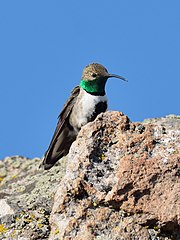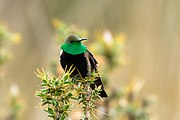| Common name | Scientific name and subspecies | Range | Size and ecology | IUCN status and estimated population |
|---|
| Ecuadorian hillstar  | Oreotrochilus chimborazo
(Delattre & Bourcier, 1846)
- O. c. jamesonii
- O. c. chimborazo
- O. c. soderstromi
| Ecuador and extreme southern Colombia.
 | Size:
Habitat:
Diet: | LC
|
|---|
| Andean hillstar 
Male

Female | Oreotrochilus estella
(d'Orbigny, 1838) | Argentina, Bolivia, Chile, and Peru.
 | Size:
Habitat:
Diet: | LC
|
|---|
| Green-headed hillstar  | Oreotrochilus stolzmanni
Salvin, 1895 | southern Ecuador and northern and central Peru
 | Size:
Habitat:
Diet: | LC
|
|---|
| White-sided hillstar 
Male

Female | Oreotrochilus leucopleurus
Gould, 1847 | Argentina, Bolivia, Chile
 | Size:
Habitat:
Diet: | LC
|
|---|
| Black-breasted hillstar 
Male

Female | Oreotrochilus melanogaster
Gould, 1847 | Peru
 | Size:
Habitat:
Diet: | LC
|
|---|
| Wedge-tailed hillstar 
Male

Female | Oreotrochilus adela
(d'Orbigny, 1838) | Argentina and Bolivia
 | Size:
Habitat:
Diet: | LC
|
|---|
| Blue-throated hillstar  | Oreotrochilus cyanolaemus
Sornoza-Molina, Freile, Nilsson, J, Krabbe & Bonaccorso, 2018 | Ecuador
 | Size:
Habitat:
Diet: | |
|---|

























